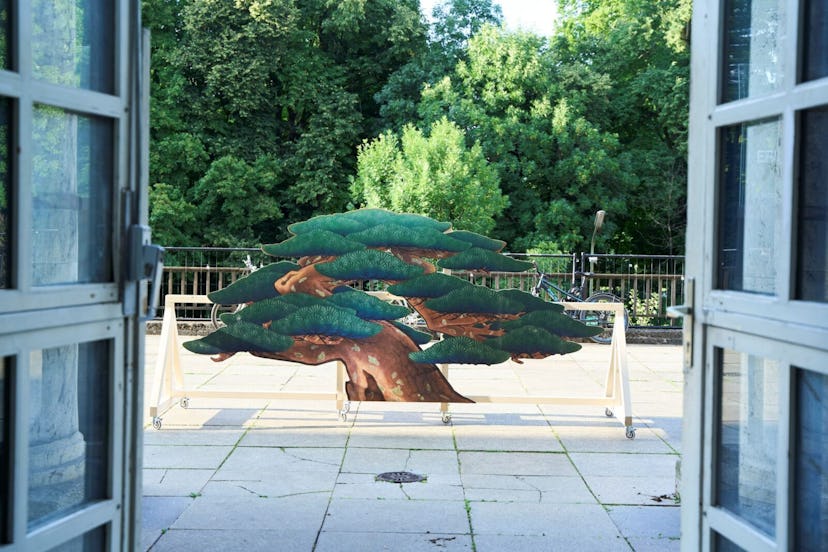Despite being Germany’s third-largest city with a population of 1.6 million, Munich is often described as a village. Verdant and cozy, nestled near the Alps, life feels slower there than in cosmopolitan Berlin, and tradition is embraced in a way few places can match (yes, lederhosen and dirndls are worn year-round, not just for Oktoberfest). “The novelist Thomas Mann wrote that ‘Munich shone’,” says Dr. Sonja Lechner, a local art historian and curator. “He understood how vibrant the Bavarian capital has always been.” She notes that the coexistence of the traditional and the modern is what makes Munich’s art scene so special. “At the end of the 19th century, art began to break away from the saturated and established: the first secession was founded in Munich in 1892, and others in Vienna and Berlin followed suit.”
“Just by taking a walk through the art district, you can explore antiquity, old masters, and modern masterpieces in the museums, as well as young, contemporary art in the Academy of Fine Arts and other galleries. All of that has shaped our cultural identity in the past and continues to shape it now.” Here, a guide to discovering Munich’s rich art scene, from the classics to it’s current thriving creative community.
Haus der Kunst
Exhibition view of KOO JEONG A. HOUSE OF MAGNETS at Haus der Kunst, 2025
Built between 1933 and 1937 at Adolf Hitler’s request, the Haus der Kunst (“House of Art”) is an imposing neoclassical structure at the southern edge of Munich’s Englischer Garten, one of the world’s largest urban parks. Originally conceived as a showcase for Nazi-approved art, the museum radically reinvented itself after World War II and is now dedicated to international contemporary art, presenting around ten exhibitions annually. Over the decades, it has hosted major retrospectives of artists including Ai Weiwei, Louise Bourgeois, Matthew Barney, and Amrita Sher-Gil. An exhibition by Cyprien Gaillard, which opened in October 2025, examines how the building itself stands as a monument to its own fraught history.
After exploring the galleries, stop for a drink at the Goldene Bar—an opulent, high-ceilinged space with a distinctly bohemian atmosphere—before heading outside to the Eisbach canal, where wetsuit-clad surfers have been riding its famous standing wave since the 1970s, rain or shine.
Exhibition view of, For Children. Art Histories since 1968, Haus der Kunst, 2025
The Lenbachhaus
Lembachhaus
Home to the world’s most comprehensive collection of works by the groundbreaking Blue Rider (Der Blaue Reiter) artists—including Wassily Kandinsky, Franz Marc, and Gabriele Münter—the marigold-hued Lenbachhaus is a jewel of Munich’s city center. Housed in the former villa of 19th-century painter Franz von Lenbach, the gallery truly came into its own after a major renovation by Norman Foster, which began in 2009 and restored the historic building, adding a striking contemporary wing. The revitalized museum reopened to the public in 2013.
A dazzling centerpiece greets visitors in the atrium: Olafur Eliasson’s Wirbelwerk, a suspended glass-and-steel installation that refracts light in a mesmerizing swirl of color. After touring the galleries, stop at ELLA, the museum’s acclaimed restaurant, where diners can enjoy refined Mediterranean fare and sweeping views over the neoclassical Königsplatz square.
Exhibition view of the Auguste Herbin exhibition at Lenbachhaus Munich, 2025
The Museum of Urban and Contemporary Art (MUCA)
Founded in 2016 in an a converted power substation, the Museum of Urban and Contemporary Art (MUCA) is Germany’s first institution dedicated entirely to street art and urban culture. The gallery has hosted exhibitions by artists including Damien Hirst, Shpard Fairey, and Banksy. Beyond its rotating shows, it also offers guided English-language bicycle tours with stops at the city’s colorful graffiti walls—from the Isar river to Munich’s lively meatpacking district.
Exhibition view of Vhils - Strata, Selected works: 2005 - 2025, Museum of Urban and Contemporary Art (MUCA)
Alte Pinakothek
Alte Pinakothek
Munich’s Pinakotheken form a triptych of museums: the Alte Pinakothek, Neue Pinakothek, and Pinakothek der Moderne. The Alte Pinakothek is among the world’s oldest art galleries, housing more than 700 works spanning the 14th to the 18th centuries, including Virgin and Child by Leonardo da Vinci and Albrecht Dürer’s Self-Portrait with Fur-Trimmed Robe. The building was severely damaged during World War II; its reconstruction—completed in 1957 under architect Hans Döllgast—intentionally retained visible traces of destruction, merging old and new masonry.
Meanwhile, the Neue Pinakothek has been closed since 2019 for extensive renovation, with reopening currently projected for around 2029. During its closure, a curated selection of 19th-century masterpieces—by artists such as Turner, Van Gogh, Monet, Manet, and Cézanne—are on display in the east wing of the Alte Pinakothek and in the Sammlung Schack.
Exhibition view of Old Masters in Motion at Alte Pinakothek
Museum Brandhorst
Museum Brandhorst
Featuring a whimsical façade—36,000 colorful ceramic rods—the Museum Brandhorst is a stone’s throw away from the three Pinakothek galleries, located in what’s known as Munich’s Kunstareal—the city’s museum district. Through January 2026, the Brandhorst presents You Are the Weather a photographic series by Roni Horn featuring portaits of a woman shot in Icelandic hot springs—her expressions and reflections mirroring the shifting elements.
Installation view of Roni Horn, You Are the Weather, 1994-96
